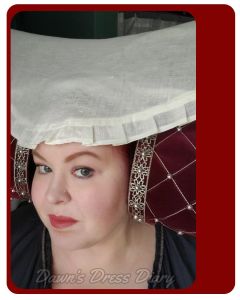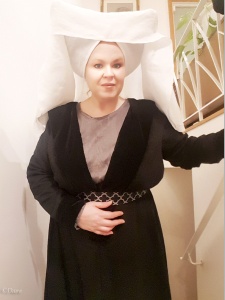
Wearing my Cross Tree Headdress
After wanting to make the Cross Tree headdress (aka Reticulated Headdress) for years I’ve finally done it – and of course, already have ideas for a future version.

Wearing my Cross Tree Headdress
After wanting to make the Cross Tree headdress (aka Reticulated Headdress) for years I’ve finally done it – and of course, already have ideas for a future version.

Wearing my Cross Tree Headdress
In a previous post I showed the steps of making my own Cross Tree headdress, and in this post I’ll be looking at the veil.
When I first looked at the effigies and monumental brasses, I thought that it was possible that the veil was a heavier fabric, and pleated, with a frill at the front edge of Countess Beatrice of Portugal’s Cross Tree Headdress. However as I started to make my own interpretation, I decided against this, and explored other options.
So far in my searching I’ve also seen the cross-tree headdress referred to as a reticulated headdress as well, but I’ll be referring to it mostly as a Cross Tree headdress, largely for my own searchability when I come back to this post later…

Wearing my Cross Tree Headdress
In a previous post I looked at the effigy I find most inspiring for the Cross Tree headdress style, along with additional similar-but-different effigies and monumental brasses. I also did a previous post looking at other reenactors, cosplayers, costumers, and milliners who did their own interpretation of the Cross Tree headdress.
In this post, I’ll be showing the steps of making my own Cross Tree headdress (or at least my first… goodness knows there might be a version 1, 2, and 3 before I am fully satisfied!) and then in a future post I’ll show off the finished hat.
So far in my searching I’ve also seen the cross-tree headdress referred to as a reticulated headdress as well, but I’ll be referring to it mostly as a Cross Tree headdress, largely for my own searchability when I come back to this post later…

Selfie in my new horned hennin
While researching my red horned hennin (to the side), I kept coming across the Cross Tree Headdress as well, (or examples like it) and little by little, it got into my head that I should try this style of over-the-top enormous hat to add to my collection of really wacky 15th century headwear.
In this post I’ll be looking at the interpretations (and research) of other costumers, cosplayers, and hat-makers.
So far in my searching I’ve also seen the cross-tree headdress referred to as a reticulated headdress as well, but I’ll be referring to it mostly as a Cross Tree headdress, largely for my own searchability when I come back to this post later…

Selfie in my new horned hennin
While researching my red horned hennin, I kept coming across the Cross Tree Headdress as well, (or examples like it) and little by little, it got into my head that I should try this style of over-the-top enormous hat to add to my collection of really wacky 15th century headwear.
So far in my searching I’ve also seen the cross-tree headdress referred to as a reticulated headdress as well, but I’ll be referring to it mostly as a Cross Tree headdress, largely for my own searchability when I come back to this post later…

V-neck Burgundian gown worn with a white horned hennin
Unfortunately, nearly everything I’ve seen of this style is modern makes – and even then it’s scant compared to the truncated hennin (like a Fez), steeple hennin (pointy princess hat), or less-seen templar/ heart-shaped or horned hennins. Likewise, I suspect this style was one of those flash-in-the-pan styles based of cauls or crespines / crespinettes / tubular cauls / templettes , which are also much more visible in period artwork.
(Goodness there are a lot of different names for similar styles – likely coming from different languages I suspect, and different interpretations of styles.)
That means seeking a period source was my first plan, followed by looking to see what else had been made by costumers and cosplayers.